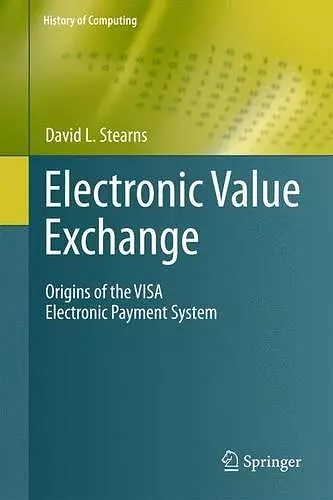Electronic Value Exchange
Origins of the VISA Electronic Payment System
Format:Paperback
Publisher:Springer London Ltd
Published:25th Feb '13
Currently unavailable, our supplier has not provided us a restock date
This paperback is available in another edition too:
- Hardback£149.99(9781849961387)

Electronic Value Exchange examines in detail the transformation of the VISA electronic payment system from a collection of non-integrated, localized, paper-based bank credit card programs into the cooperative, global, electronic value exchange network it is today. Topics and features: provides a history of the VISA system from the mid-1960s to the early 1980s; presents a historical narrative based on research gathered from personal documents and interviews with key actors; investigates, for the first time, both the technological and social infrastructures necessary for the VISA system to operate; supplies a detailed case study, highlighting the mutual shaping of technology and social relations, and the influence that earlier information processing practices have on the way firms adopt computers and telecommunications; examines how “gateways” in transactional networks can reinforce or undermine established social boundaries, and reviews the establishment of trust in new payment devices.
From the reviews:
“David L. Stearns argues in Electronic Value Exchange: Origins of the Visa Electronic Payment System that the job of a historian of technology is to make invisible technologies visible again. Certainly, he has achieved this goal. … Stearns’ Electronic Value Exchange is a much-needed contribution to the literature.” (Joline Zepcevski, Enterprise and Society, Vol. 13 (2), June, 2012)
“In this well-written, concise volume Stearns … details both the technological and organizational challenges that Visa had to overcome in order to link merchants and financial institutions into a seamless worldwide electronic network. … a valuable contribution to not only the history of technology, but the broader fields of financial, consumer, and business history. … Among the many strengths of this book is its crystal clear writing style. … Overall, Electronic Value Exchange will be of interest to a wide variety of scholars.” (David L. Mason, EH, February, 2012)
“Stearns offers a fascinating narrative that navigates somewhere between the sociology of finance, social studies of technology, retail banking and business history. … There is an alphabetic index and most references appear as footnotes. … There is also a list of interviewees and a helpful list of acronyms. … The style is open and quite engaging, the discussion is easy to follow … . developments are explained largely without jargon and with the non-specialist reader very much in mind.” (NEP-HIS blog, February, 2012)
“Book provides a socio-technical account of VISA, a banking service to which banks that issued cards belonged and that sold card-processing services to merchants. … a readable volume, based on an extensive set of interviews of protagonists of the story and on secondary theoretical and banking literature. … a welcome addition to the history of banking and of information technologies, and a useful example of how to examinethe role of any modern technology within the cultural and operational context in which it is used.” (James W. Cortada, Technology and Culture, Vol. 53, January, 2012)
“In this book from the ‘History of Computing’ series from Springer, Stearns looks at the origins of the VISA electronic payment system. … Stearns combines many of these aspects into a very readable book, covering the historical growth of VISA, the personalities involved in its rise, and the computing technology that underpins the organization. Swiping my VISA card will never be quite the same again.” (David B. Henderson, ACM Computing Reviews, August, 2011)
ISBN: 9781447126232
Dimensions: unknown
Weight: unknown
240 pages
2011 ed.